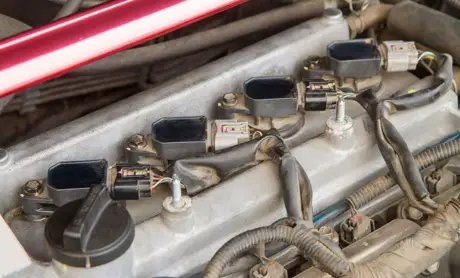
The ignition coil is designed to convert the low onboard voltage of the car into high voltage, which is required to generate the ignition spark at the spark plug. While ignition coils generally last a lifetime, external factors can impair their functionality and cause a defect.
Symptoms of a Faulty Ignition Coil
- Difficult or failed engine start
- RPM fluctuations
- Uneven engine running
- Loss of power
- Increased fuel consumption
A typical symptom indicating the failure of one or more ignition coils is misfiring or the complete absence of the ignition spark in one of the cylinders. In modern vehicles, the systems for monitoring exhaust composition are very sensitive, which is why these faults are often quickly detected by the On-Board Diagnostics (OBD).
Furthermore, there can be uneven engine running, both at idle and during acceleration. Loss of power and increased fuel consumption should also attract attention. However, this does not mean that the ignition coils are always defective, as damaged spark plugs and ignition cables can also be responsible for these symptoms and should therefore be checked first.
It should be noted that other malfunctions of the ignition system can manifest in a similar way, which is why the final diagnosis is often made in a workshop. When the ignition coil fails and needs to be replaced, it is also worth replacing the spark plugs and ignition cables, as well as the distributor cap and rotor in vehicles with a distributor.
Causes of a Faulty Ignition Coil

Like the symptoms, the causes of ignition coil failure are varied. A frequently overlooked cause is inferior or worn ignition cables, but ignition coils not compatible with the engine can also quickly self-destruct. Damage often occurs due to improper installation and removal of the coils.
Single spark coils are very susceptible to high temperatures due to their installation location, which is why no expenses should be spared when replacing them, and high-quality replacement parts should be used. However, ignition coils can also fail if they cannot discharge their charge anywhere. This can be caused by a missing contact, a broken high-voltage cable, or its disconnection while the engine is running.
If the ignition coil comes into contact with water, for example, after an engine wash, this can also cause a defect. Furthermore, ignition coils are constantly exposed to moist air that penetrates under the hood, especially in the colder season, which can potentially attack the ignition coils.
To correctly diagnose the cause, a so-called ignition timing light (stroboscope lamp) is used to measure the ignition timing. The next step is to check the resistance of the primary and secondary windings of the ignition coil.
Fauly Ignition Coil – What Now?

The consequences of driving with a defective ignition coil are damage to other components, such as the catalytic converter, which is destroyed by the ignition of unburned fuel. In addition, the affected cylinder could suffer from piston seizure, as the oil film is removed by the injected gasoline. It is therefore extremely important to visit a trustworthy car workshop at the first signs of a defect.
Same articles

Understanding Vehicle Inspection and Verification Services: Why They Matter for Every Driver
GuidesVehicle inspection and verification services are an essential but often overlooked part of keeping roads safe and cars legally compliant. Most people only think about inspections when it’s...
KLIFEX Brand Overview: High-Quality Automotive Repair Kits for Affordable Repairs
GuidesThe automotive aftermarket has long needed solutions that combine reliability, durability, and affordability. Many car enthusiasts and services are looking for a way...
Fast, Reliable Vehicle Emissions & Inspection Services Made Simple
GuidesFast, reliable emissions and inspection services are essential for keeping vehicles road-ready, compliant with environmental regulations, and safe for daily driving. If you’re looking for quick...

